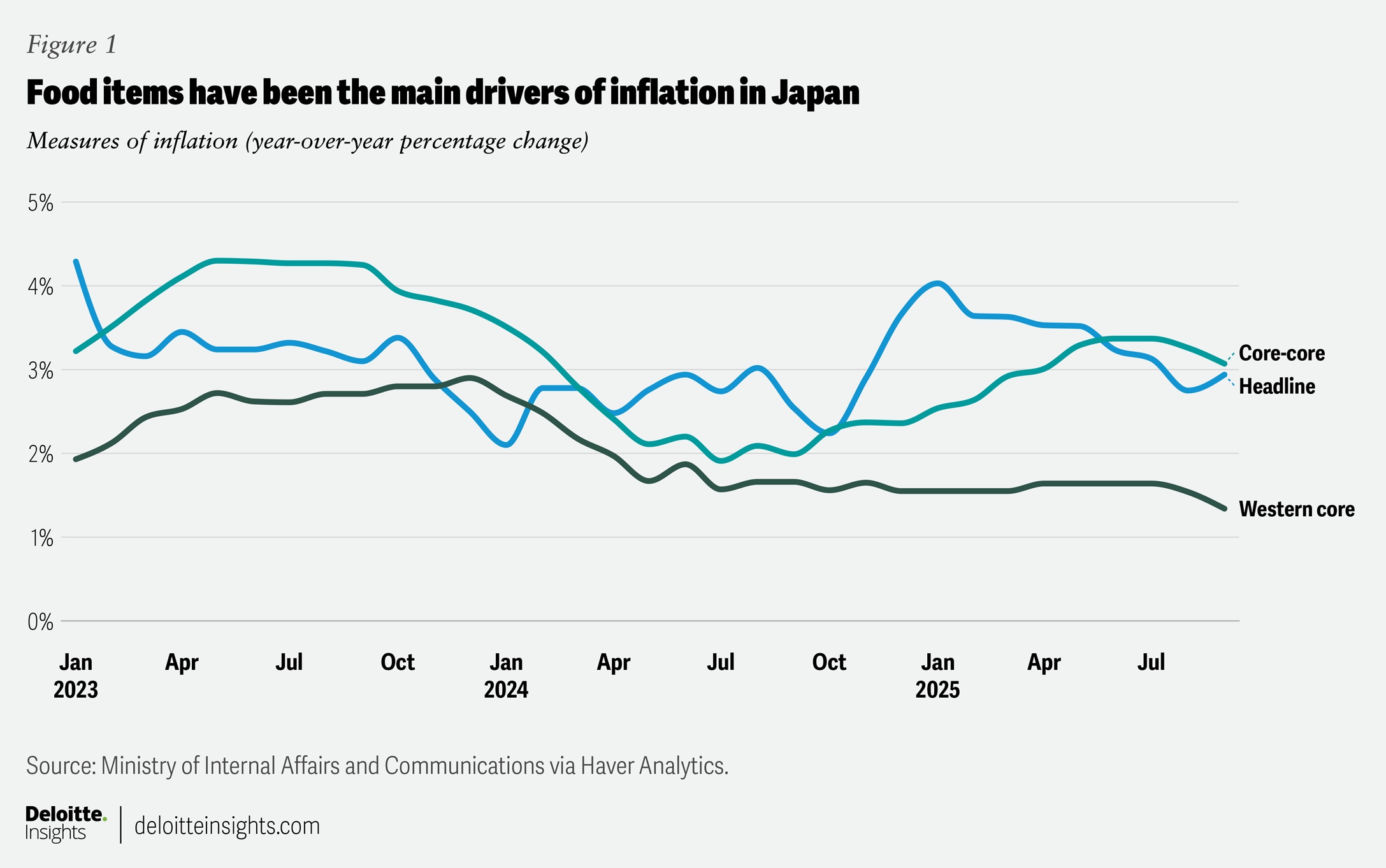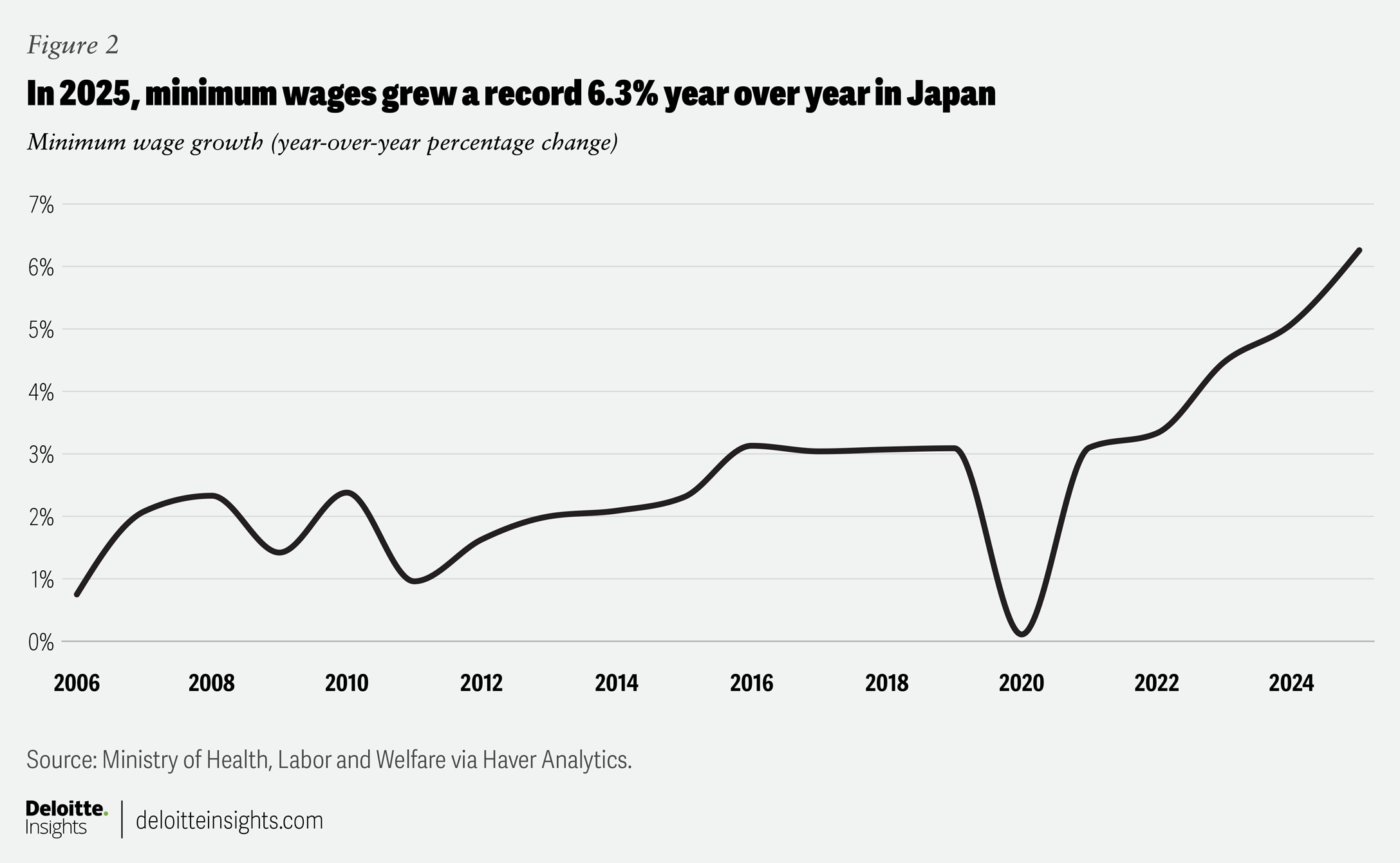Japan economic outlook, October 2025
Political shifts, rising interest rates, food-price inflation, and a major US trade investment commitment are driving a subdued outlook for the Japanese economy
Prime Minister Shigeru Ishiba announced his resignation in September, after the ruling coalition lost its majority in the upper house of the Diet (or, parliament) in July. After elections, on Oct. 21, 2025, the new leader of the Liberal Democratic Party (LDP), Sanae Takaichi, became the prime minister of Japan—the first woman to hold the office.1
Her leadership may involve expanding the LDP’s coalition to include other parties. From an economic standpoint, a broader coalition will likely require more concessions, which could lead to looser fiscal policy overall. This comes at a time when interest rates are rising. Indeed, the yield on the 10-year Japanese government bond reached its highest level since 2008 at the end of September.
Adding to Japan’s fiscal woes is the huge US$550 billion investment it has promised to the United States to bring tariffs down. There are still large uncertainties around this investment commitment, and around how much of it can be loans or guarantees as opposed to actual investment spending.2 Although she has since walked back her position, Takaichi had previously suggested that Japan should renegotiate its tariff and investment deal with the United States, which raises uncertainty about Japan’s relationship with its largest export market.3
Growth in slow gear
Prior to the political upheaval, Japan’s economy grew by an annualized rate of 2.2% between the first and second quarters of 2025.4 The relatively strong performance was largely due to an improvement in the trade balance as exporters rushed to get goods across the border before US tariffs went into effect. This is unlikely to be repeated in subsequent quarters.
Business investment was also relatively strong, rising an annualized 2.6% over the same period—the third consecutive quarter with growth above 2%. Other categories were more subdued. For example, final domestic household consumption grew just 1.3%.5 Meanwhile, government spending fell for a second consecutive quarter as public investment continued to decline.
Excluding international trade, the economy grew by about 1%, which points to relatively weak domestic demand. Since the second quarter, domestic demand seems to have waned. The real consumption activity index was unchanged from a year earlier in July.6 This was entirely due to slower nominal spending rather than higher inflation. Consumer confidence has improved somewhat since hitting a low in April, but remained 6.3% lower than a year earlier in August.7
A government survey of business conditions shows that large companies are less optimistic than they were a year earlier in the third quarter.8 They are even less optimistic about the fourth quarter of this year.
A large obstacle to stronger growth and confidence in the economy is coming from elevated inflation. Even so, the Bank of Japan (BOJ) left its policy rate unchanged again in September despite relatively high inflation. Two voting members dissented, opting for a rise in interest rates instead.9 Still, the BOJ announced that it would sell some of its exchange-traded funds and real estate investment trusts. The central bank has expressed concern that US trade policy could weaken Japan’s growth prospects, requiring a more dovish monetary policy stance.10 The presence of two dissenters, combined with recent comments from other BOJ officials, signals that the central bank could raise rates before the end of this year. Plus, headline inflation and core inflation, which excludes fresh food, are firmly above the central bank’s 2% target.
However, additional rate hikes are by no means certain as the durability of inflation remains questionable. Headline inflation is moving due to factors unrelated to domestic demand. For example, energy and government subsidies for education were the main contributors to the recent drop in headline inflation.11 At the same time, food prices are pushing inflation in the other direction. Rice prices were up 49.1% from a year ago, while the prices of coffee, cakes, and candies are also rising quickly.
Food items are currently the principal drivers of inflation. When fresh food and energy are excluded from prices, core-core inflation was 3.1% in September on a year-ago basis. But if we exclude all food and nonalcoholic beverages in addition to energy, western core inflation was just 1.3%—the lowest reading since September 2022 (figure 1). This means that most of the inflationary impulse in the economy is coming from food items that do not fall in the fresh food category—mainly rice, cakes and candies, and coffee.12

Other forces, such as crop yields, have an outsized effect on the prices of these food items. Coffee13 and cocoa prices14 are rising quickly globally, which has little to do with demand in Japan. Instead, climate-related issues have worsened yields of the underlying crops and sent prices higher. Rice prices are also exceptionally high due to climate-related issues that hurt yields. However, Japan also provides incentives to farmers to curb their production of rice to prevent rice prices from moving too low, which has prevented a greater supply of rice that could bring prices back down.15 Fortunately, rice prices are beginning to fall, at least slightly. To be clear, rice prices were up a lofty 49.1% from a year earlier in September, but that was down markedly from a 100.1% increase in June.16
The BOJ’s own measures of underlying inflation are providing slightly mixed messages, but none of them is signaling runaway inflation. For example, trimmed mean inflation was 2% in August, which is exactly the central bank’s target.17 This is also lower than at any point in the first half of 2025. Mode inflation increased from 1.5% to 1.9% in August, but it remains below target. The weighted median inflation measure was just 1.1% in August—well below target and also the lowest reading since December 2024.18 None of these measures of underlying inflation are particularly worrying at this point, though the jump in mode inflation accompanied by strong headline inflation should be enough to justify a rate hike this year.
Inflationary pressures are limited
A weak yen has been blamed for the strong inflation seen in Japan. However, it is highly unlikely that this is still the case. For one, import prices are falling on a year-ago basis. Import prices for all commodities were down 0.8% in September.19 Plus, although the yen weakened following the LDP election, it remains roughly where it was a year earlier. In addition, at around 151 per US dollar in October, it is still stronger than the 156.7 reading in January.20 Moreover, as the central bank in the United States continues to cut interest rates and if the BOJ raises them, this should cause the yen to appreciate further.
Evidence of a wage-price spiral, where wages and prices continue to push each other higher, is also in short supply. Inflation-adjusted wages per worker were still declining on a year-ago basis in August, even after including bonus payments and overtime.21 As we have highlighted in previous outlooks, it is the number of hours worked rather than the hourly compensation that is restraining wage growth per worker. While this may signal a better balance for Japanese workers who are able to work less and receive similar pay, this does not signal a situation where wages are pushing prices higher. Indeed, workers are still losing purchasing power.
There is one place where a wage-price spiral could begin to occur. Minimum wages were raised by a record 6.3% on average (figure 2).22 This wage hike will gradually come into effect beginning in October. This could push food inflation even higher as grocery stores, restaurants, and convenience stores employ many workers at a minimum wage. However, less than 5% of employees are paid the minimum wage.

Stronger wage growth for the other 95% of workers will likely be more muted early next year. Although the labor market remains relatively tight, the unemployment rate jumped from 2.3% in July to 2.6% in August. Plus, many of Japan’s largest companies are struggling with US tariffs.
Large automakers typically set the trend during the spring wage negotiations, or shunto. However, motor vehicle exports were down 0.6% on a year-ago basis in September—the sixth consecutive month of declines. As a result, their margins are getting squeezed,23 so it is likely that wage hikes in 2026 will not be as generous as they were during the previous two years.
Overall, economic growth is expected to remain positive but subdued. Consumer spending will struggle to break higher while food inflation remains strong. The BOJ is unlikely to be able to have much influence on that part of inflation for now. In addition, export growth will likely remain limited while trade barriers persist. On the plus side for growth is that government spending will likely become looser, but this may come at the expense of higher interest rates.